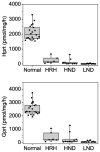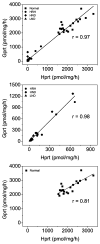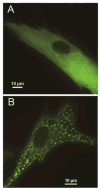Clinical severity in Lesch-Nyhan disease: the role of residual enzyme and compensatory pathways
- PMID: 25481104
- PMCID: PMC4277921
- DOI: 10.1016/j.ymgme.2014.11.001
Clinical severity in Lesch-Nyhan disease: the role of residual enzyme and compensatory pathways
Abstract
Mutations in the HPRT1 gene, which encodes the purine salvage enzyme hypoxanthine-guanine phosphoribosyltransferase (HGprt), cause Lesch-Nyhan disease (LND) and more mildly affected Lesch-Nyhan variants. Prior studies have suggested a strong correlation between residual hypoxanthine recycling activity and disease severity. However, the relevance of guanine recycling and compensatory changes in the de novo synthesis of purines has received little attention. In the current studies, fibroblast cultures were established for 21 healthy controls and 36 patients with a broad spectrum of disease severity related to HGprt deficiency. We assessed hypoxanthine recycling, guanine recycling, steady-state purine pools, and de novo purine synthesis. There was a strong correlation between disease severity and either hypoxanthine or guanine recycling. Intracellular purines were normal in the HGprt-deficient fibroblasts, but purine wasting was evident as increased purine metabolites excreted from the cells. The normal intracellular purines in the HGprt-deficient fibroblasts were likely due in part to a compensatory increase in purine synthesis, as demonstrated by a significant increase in purinosomes. However, the increase in purine synthesis did not appear to correlate with disease severity. These results refine our understanding of the potential sources of phenotypic heterogeneity in LND and its variants.
Keywords: Genotype–phenotype correlation; Inherited metabolic disease; Purine metabolism; Purinosome.
Copyright © 2014 Elsevier Inc. All rights reserved.
Figures




Similar articles
-
Do clinical features of Lesch-Nyhan disease correlate more closely with hypoxanthine or guanine recycling?J Inherit Metab Dis. 2016 Jan;39(1):85-91. doi: 10.1007/s10545-015-9869-x. Epub 2015 Jun 12. J Inherit Metab Dis. 2016. PMID: 26067813 Free PMC article.
-
Overproduction of uric acid in hypoxanthine-guanine phosphoribosyltransferase deficiency. Contribution by impaired purine salvage.J Clin Invest. 1979 May;63(5):922-30. doi: 10.1172/JCI109392. J Clin Invest. 1979. PMID: 447834 Free PMC article.
-
Consequences of impaired purine recycling on the proteome in a cellular model of Lesch-Nyhan disease.Mol Genet Metab. 2015 Apr;114(4):570-579. doi: 10.1016/j.ymgme.2015.02.007. Epub 2015 Mar 5. Mol Genet Metab. 2015. PMID: 25769394 Free PMC article.
-
Hypothesized deficiency of guanine-based purines may contribute to abnormalities of neurodevelopment, neuromodulation, and neurotransmission in Lesch-Nyhan syndrome.Clin Neuropharmacol. 2005 Jan-Feb;28(1):28-37. doi: 10.1097/01.wnf.0000152043.36198.25. Clin Neuropharmacol. 2005. PMID: 15711436 Review.
-
Potential molecular link between the β-amyloid precursor protein (APP) and hypoxanthine-guanine phosphoribosyltransferase (HGprt) enzyme in Lesch-Nyhan disease and cancer.AIMS Neurosci. 2021 Oct 28;8(4):548-557. doi: 10.3934/Neuroscience.2021030. eCollection 2021. AIMS Neurosci. 2021. PMID: 34877405 Free PMC article. Review.
Cited by
-
From purines to purinergic signalling: molecular functions and human diseases.Signal Transduct Target Ther. 2021 Apr 28;6(1):162. doi: 10.1038/s41392-021-00553-z. Signal Transduct Target Ther. 2021. PMID: 33907179 Free PMC article. Review.
-
P2X7 Receptor and Purinergic Signaling: Orchestrating Mitochondrial Dysfunction in Neurodegenerative Diseases.eNeuro. 2022 Nov 14;9(6):ENEURO.0092-22.2022. doi: 10.1523/ENEURO.0092-22.2022. Print 2022 Nov-Dec. eNeuro. 2022. PMID: 36376084 Free PMC article. Review.
-
Purinosomes and Purine Metabolism in Mammalian Neural Development: A Review.Acta Histochem Cytochem. 2024 Jun 28;57(3):89-100. doi: 10.1267/ahc.24-00027. Epub 2024 Jun 22. Acta Histochem Cytochem. 2024. PMID: 38988694 Free PMC article. Review.
-
Towards personalized chemotherapy of acute lymphoblastic leukemia.Oncotarget. 2018 Dec 4;9(95):36728-36729. doi: 10.18632/oncotarget.26420. eCollection 2018 Dec 4. Oncotarget. 2018. PMID: 30613359 Free PMC article. No abstract available.
-
Study of purinosome assembly in cell-based model systems with de novo purine synthesis and salvage pathway deficiencies.PLoS One. 2018 Jul 30;13(7):e0201432. doi: 10.1371/journal.pone.0201432. eCollection 2018. PLoS One. 2018. PMID: 30059557 Free PMC article.
References
-
- Jinnah HA, DeGregorio L, Harris JC, Nyhan WL, O'Neill JP. The spectrum of inherited mutations causing HPRT deficiency: 75 new cases and a review of 196 previously reported cases. Mutat Res. 2000;463:309–326. - PubMed
-
- Schretlen DS, Harris JC, Park KS, Jinnah HA, Ojeda del Pozo N. Neurocognitive functioning in Lesch-Nyhan disease and partial hypoxanthine-guanine phosphoribosyltransferase deficiency. J Int Neuropsychol Soc. 2001;7:805–812. - PubMed
Publication types
MeSH terms
Substances
Grants and funding
LinkOut - more resources
Full Text Sources
Other Literature Sources
Miscellaneous

